Discover 35 hidden attractions, cool sights, and unusual things to do in Adelaide (Australia). Don't miss out on these must-see attractions: Art Gallery of South Australia, Adelaide Zoo, and Adelaide Central Market. Also, be sure to include The Beachouse in your itinerary.
Below, you can find the list of the most amazing places you should visit in Adelaide (South Australia).
Table of Contents
Art Gallery of South Australia

Colonnaded gallery founded in 1881. The Art Gallery of South Australia, established as the National Gallery of South Australia in 1881, is located in Adelaide. It is the most significant visual arts museum in the Australian state of South Australia. It has a collection of almost 45,000 works of art, making it the second largest state art collection in Australia. As part of North Terrace cultural precinct, the gallery is flanked by the South Australian Museum to the west and the University of Adelaide to the east.
As well as its permanent collection, which is especially renowned for its collection of Australian art, AGSA hosts the annual Festival of Contemporary Aboriginal and Torres Strait Islander Art known as Tarnanthi, displays a number of visiting exhibitions each year and also contributes travelling exhibitions to regional galleries. European (including British), Asian and North American art are also well represented in its collections.
As of February 2022 the Director of AGSA is Rhana Devenport ONZM.[1]
Address: North Terrace, 5000 Adelaide (Adelaide)
Adelaide Zoo

Longtime collection of familiar animals. Adelaide Zoo is Australia's second oldest zoo, and it is operated on a non-profit basis. It is located in the parklands just north of the city centre of Adelaide, South Australia. It is administered by the Royal Zoological Society of South Australia Incorporated, which is a full institutional member of the Zoo and Aquarium Association and the World Association of Zoos and Aquariums, and which also administers the Monarto Safari Park near Murray Bridge.
The zoo houses about 300 native and exotic species, with over 3,000 animals on site. The zoo's most recent enclosures are in the second phase of the South-East Asia exhibit, known as Immersion, providing visitors with the experience of walking through the jungle, with Sumatran tigers and orangutans seemingly within reach.
Five buildings within the zoo have been listed as state heritage places on the South Australian Heritage Register, including the front entrance on Frome Road and the former Elephant House. The zoo is also a botanical garden and the grounds contain significant exotic and native flora, including a Moreton Bay fig planted in 1877.
The giant panda exhibit, which opened in December 2009, is home to two giant pandas, Wang Wang and Funi, which will remain at the zoo until at least 2024.[2]
Address: Botanic Drive, 5000 Adelaide (Adelaide)
Adelaide Central Market
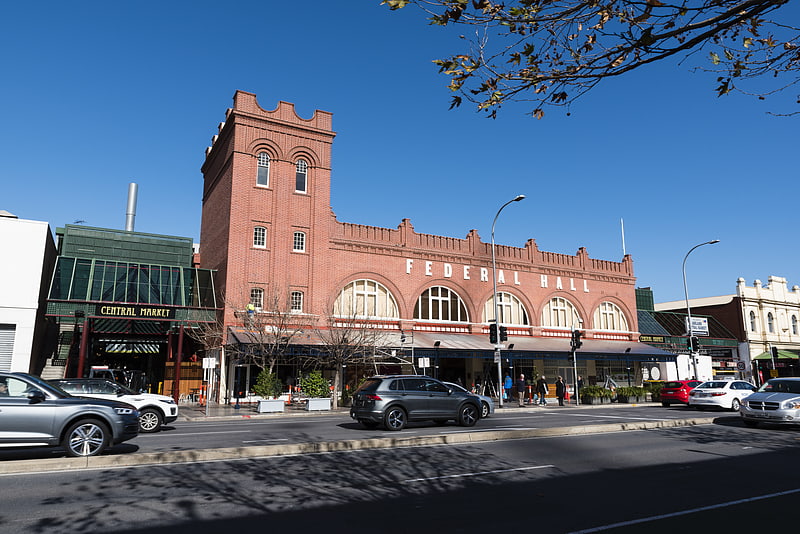
Shopping mall in Adelaide city centre, Australia. The Adelaide Central Market is a major fresh produce market in Adelaide, South Australia, Australia. As one of the oldest markets in Australia, Adelaide Central Market has a large range of fresh food, including fruit and vegetables, meat and poultry, seafood, cheeses, bakery, small goods and health foods, along with several frequently visited cafes and eateries. Currently, approximately one million kilograms of fresh produce delivered to the Market and sold every month. The market is a popular tourist attraction in the city, with more than 9.5 million visitations every year, and is also referred to as the Central Market.[3]
Address: 60 Gouger St, 5000 Adelaide (Adelaide)
The Beachouse

Amusement park in Australia. The Beachouse is a family entertainment complex located on the foreshore at Glenelg in Adelaide, South Australia. The five-story complex also features a function room, The Function, Glenelg. The Beachouse replaced the old arcade/entertainment venue, Magic Mountain which stood from 1982 to 2004.[4]
Address: Colley Terrace, 5045 Glenelg
Rundle Mall
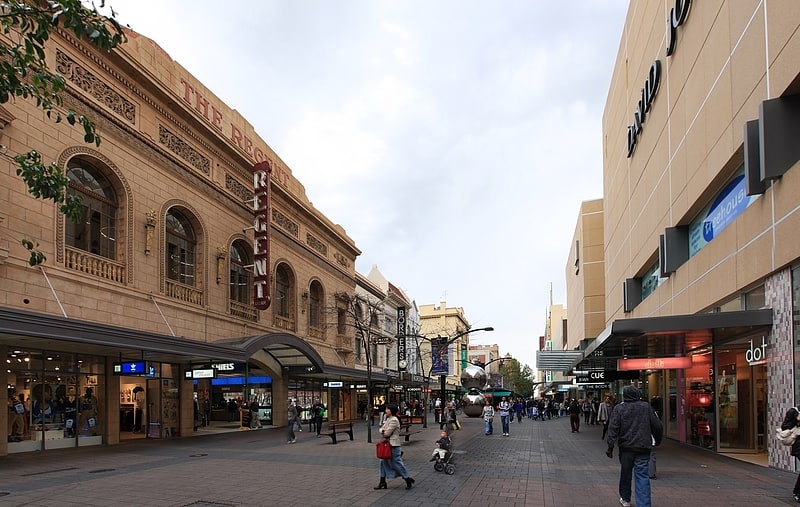
Street in Adelaide city centre, Australia. Rundle Mall is a pedestrian street mall located in Adelaide, South Australia. It was opened as a pedestrian mall in September 1976 by closing the section of Rundle Street between King William Street and Pulteney Street, to vehicular traffic. The street continues as Rundle Street to the east and Hindley Street to the west.
The pedestrian mall has become the centrepiece of Adelaide's city centre, home to some of the most expensive real estate in the state. It competes with the large shopping complexes in the suburbs, (e.g. Westfield Marion, Armada Arndale Shopping Centre, Westfield Tea Tree Plaza, etc.) In 2009, retail space directly on the mall leased for up to $3,700 per square metre per year.
The mall is home to the South Australian flagship stores of many large Australian retailers and many smaller independent and chain stores. The mall also features a number of arcades and plazas containing smaller boutiques and eateries. These include the Italianate-style Adelaide Arcade (also being the first retail establishment in Australia with electric lighting, and allegedly home to six ghosts), Regent Arcade, Gay's Arcade, City Cross, Southern Cross, Adelaide Central Plaza, Myer Centre, Renaissance Arcade, and Rundle Place.
There are usually several buskers performing in the mall, licensed by the Adelaide City Council. The mall's stores are generally open seven days a week.[5]
Address: Rundle Mall, 5000 Adelaide (Adelaide)
Rundle Street
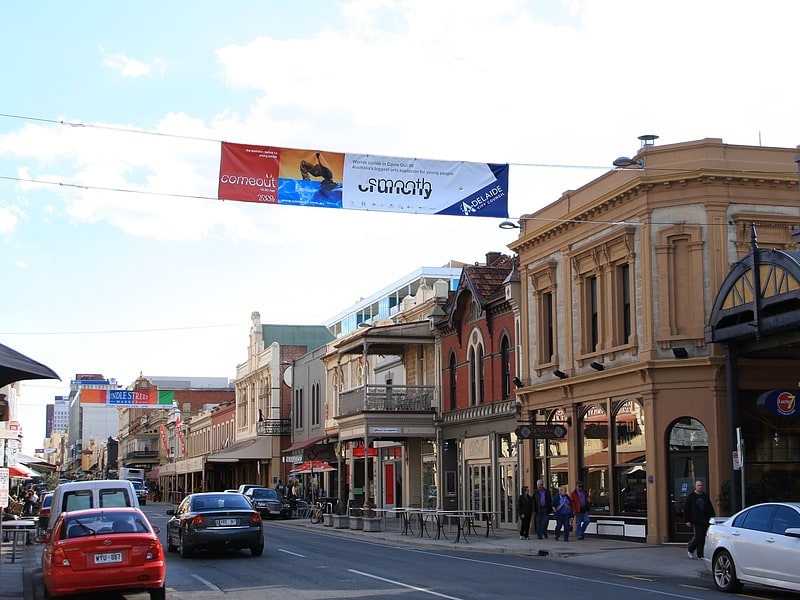
Street in Adelaide city centre, Australia. Rundle Street, often referred to as "Rundle Street East" as distinct from Rundle Mall, is a street in the East End of the city centre of Adelaide, the capital of South Australia. It runs from Pulteney Street to East Terrace, where it becomes Rundle Road through the East Park Lands. Its former western extent, which ran to King William Street, was closed in 1972 to form the pedestrian street of Rundle Mall. The street is close to Adelaide Botanic Gardens, Rundle Park / Kadlitpina, Rymill Park, Hindmarsh Square and North Terrace.
The street was named after John Rundle, a director of the South Australia Company and member of the British House of Commons, by the Street Naming Committee on 23 May 1837. It was installed with the first electric street lighting in South Australia in 1895 at the former intersection of Rundle, King William and Hindley streets.
The street contains numerous cafés, restaurants, shops, cinemas (via Cinema Place), clubs and hotels. It is one of Adelaide's most popular streets for cafés and fashion. Most of the street has a heritage façade, but has been redeveloped for modern use, with some buildings converted to residences, such as the East End Markets.
The street is two-lane with parking on both sides plus bicycle lanes. A tramline ran through the street in the early 20th century. It is one of the narrower streets of the Adelaide grid, at 1 chain (66 ft; 20 m) wide.[6]
Address: Rundle St, 5000 Adelaide (Adelaide)
National War Memorial
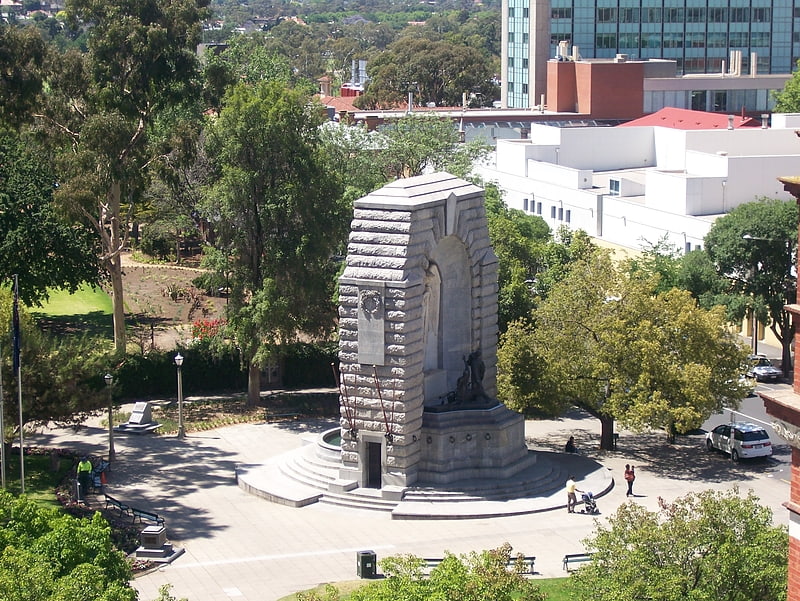
War memorial in Adelaide city centre, Australia. The National War Memorial is a monument on the north edge of the city centre of Adelaide, South Australia, commemorating those who served in the First World War. Opened in 1931, the memorial is located on the corner of North Terrace and Kintore Avenue, adjacent to the grounds of Government House. Memorial services are held at the site throughout the year, with major services on both Anzac Day and Remembrance Day.
First proposed in 1919, the memorial was funded by the Parliament of South Australia, making it the first Australian state war memorial to be confirmed after the war. The design of the memorial was selected through two architectural competitions. The first competition, in 1924, produced 26 designs—all of which were lost before judging could be completed after fire destroyed the building in which they were housed. A second competition, in 1926, produced 18 entries, out of which the design by the architectural firm Woods, Bagot, Jory & Laybourne-Smith was selected as the winner.
The design—effectively a frame for two scenes depicted through Rayner Hoff's marble reliefs and bronze statues—shows the prelude and the epilogue to war, depicting both the willingness of youth to answer the call of duty and the extent of the sacrifices which they made. In this, the work is not displaying a material victory, but instead a victory of the spirit. At the insistence of W. F. J. McCann, president of the Returned Soldiers' League, bronze tablets were cast to line the walls of an inner shrine, on which are listed the names of all South Australians who died during the Great War.[7]
Address: North Terrace, 5000 Adelaide (Adelaide)
South Australian Museum
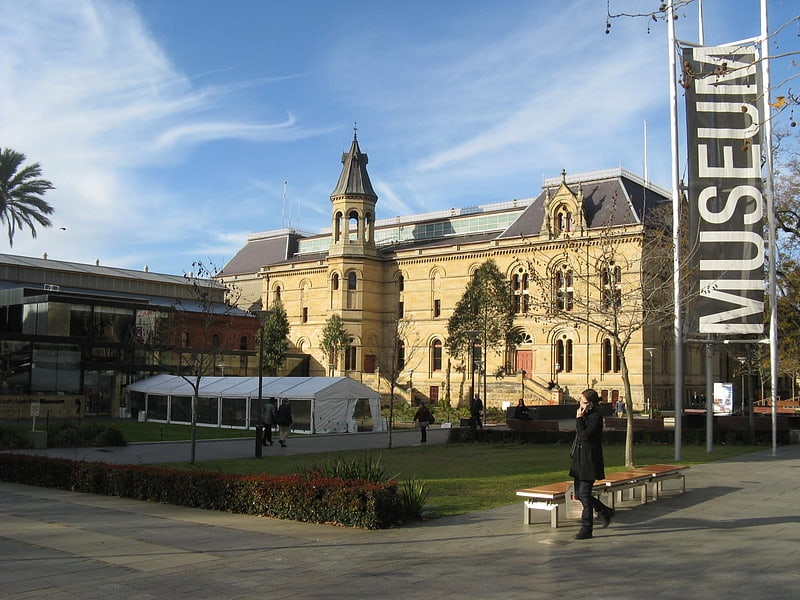
Museum in Adelaide city centre, Australia. The South Australian Museum is a natural history museum and research institution in Adelaide, South Australia, founded in 1856 and owned by the Government of South Australia. It occupies a complex of buildings on North Terrace in the cultural precinct of the Adelaide Parklands. Plans are under way to move much of its Australian Aboriginal cultural collection, into a new National Gallery for Aboriginal Art and Cultures.[8]
Address: North Terrace, 5000 Adelaide (Adelaide)
Adelaide Gaol
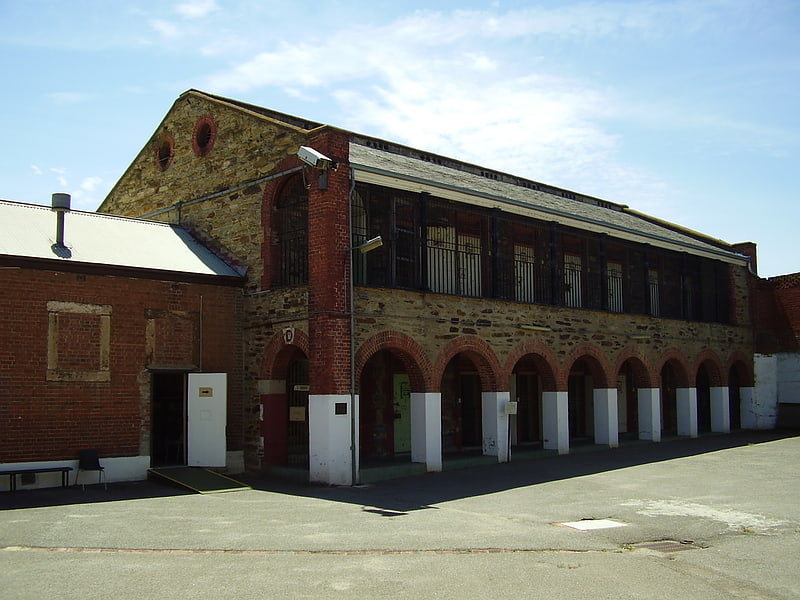
Museum in Adelaide city centre, Australia. Adelaide Gaol is a former Australian prison located in the Park Lands of Adelaide, in the state of South Australia. The gaol was the first permanent one in South Australia and operated from 1841 until 1988. The Gaol is one of the two oldest buildings still standing in South Australia, the other being Government House which was built at the same time. The prison is now a museum, tourist attraction and function centre.[9]
Address: Old Gaol 18 Gaol Rd, 5000 Thebarton (Adelaide)
Adelaide Botanic Garden
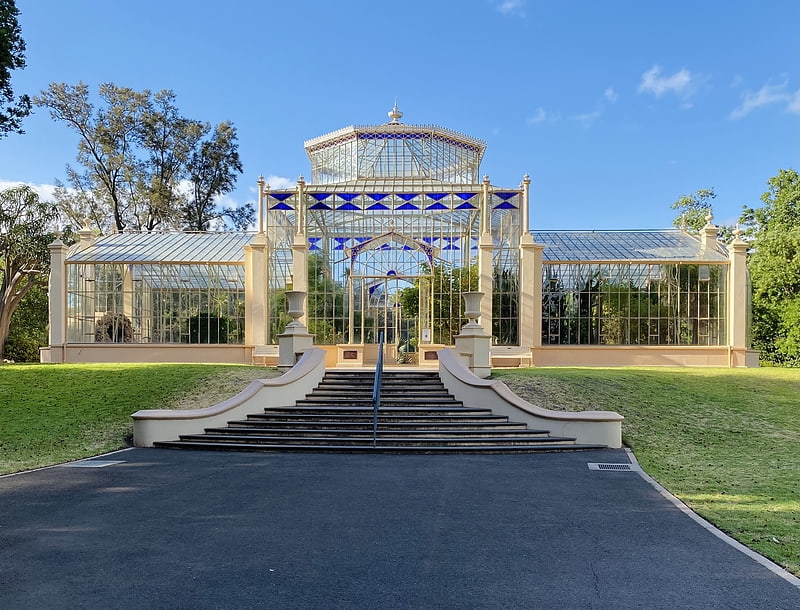
Botanical garden in Adelaide city centre, Australia. The Adelaide Botanic Garden is a 51-hectare public garden at the north-east corner of the Adelaide city centre, in the Adelaide Park Lands. It encompasses a fenced garden on North Terrace and behind it the Botanic Park. Work was begun on the site in 1855, with its official opening to the public on 4 October 1857.
The Adelaide Botanic Garden and adjacent State Herbarium of South Australia, together with the Wittunga Botanic Garden and Mount Lofty Botanic Garden, comprise the Botanic Gardens of South Australia, administered by the Board of the Botanic Gardens and State Herbarium, a state government statutory authority.[10]
Address: North Tce, 5000 Adelaide (Adelaide)
National Wine Centre of Australia
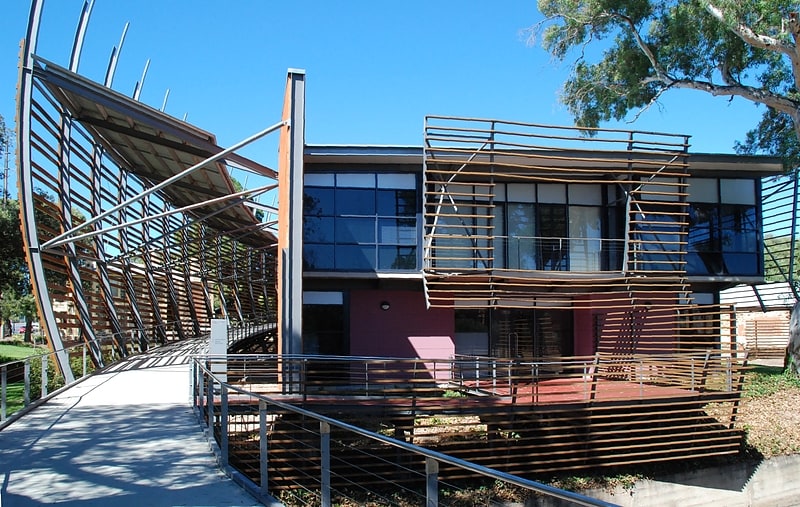
Tourist attraction in Adelaide city centre, Australia. The National Wine Centre of Australia is a public exhibition building about winemaking and its industry in South Australia, opened in 2001. It contains an interactive permanent exhibition of winemaking, introducing visitors to the technology, varieties and styles of wine. It also has a wine tasting area, giving visitors the opportunity to taste and compare wines from different areas of Australia.
The Wine Centre is situated at the eastern end of North Terrace, Adelaide in the east parklands and adjacent to the Adelaide Botanic Gardens. The building designed by Cox Grieve Gillett uses building materials to reflect items used in making wine. The exterior of the building looks like a section of a wine barrel. Outside the building are rows of grapevines, showing seven different varieties of grapes to curious visitors who normally would not have access to a vineyard to see the differences for themselves.[11]
Address: Adelaide, North Terrace, Adelaide, South Australia
Museum of Economic Botany
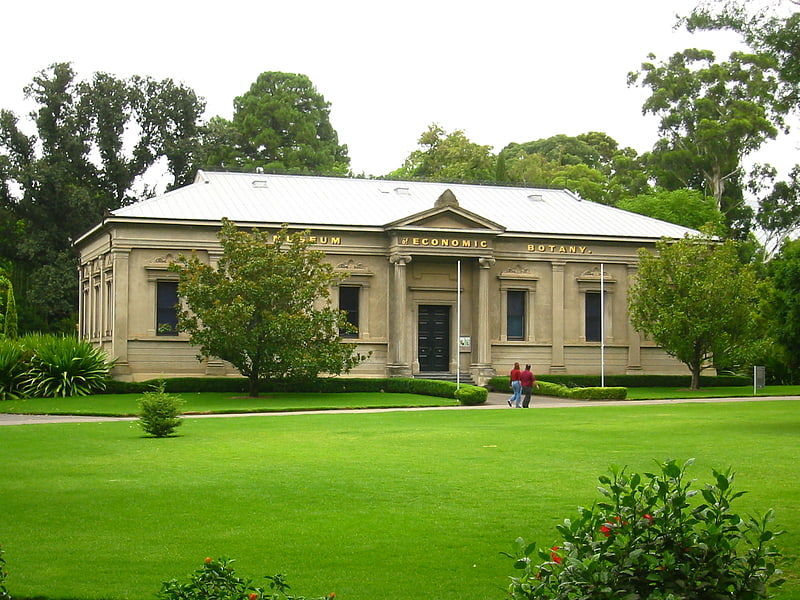
The Santos Museum of Economic Botany, located in the Adelaide Botanic Gardens, displays a permanent collection exhibiting the practical, medicinal and economic use of plant materials.
It was inspired by the museum in London's Kew Gardens, which opened in 1847, the Adelaide Museum opened in 1881 and is the sole remaining museum of its kind in Australia. Upon opening, the Museum of Economic Botany displayed 3500 objects specifically designed to show the link between the raw material and the final consumer product. It currently displays over 3000 specimens, representing 99% of collected material, and regularly hosts contemporary art exhibitions, such as Tamar Dean's photographic exhibition as part of the 2018 Adelaide Festival Biennial.
Instigated and developed by its first Director Richard Schomburgk, who drew on his international network of like-minded botanists to gather a wealth of content, the plant materials on display range from essential oils, gums and resins, fibre plants, dyes, food and beverage plants, fibres etc.
With its Greek-revival style facade, the Museum was listed on the now-defunct Register of the National Estate on 21 October 1980 and on the South Australian Heritage Register on 23 September 1982.[12]
Address: Morton Bay Fig Rd., 5000 Adelaide (Adelaide)
Montefiore Hill
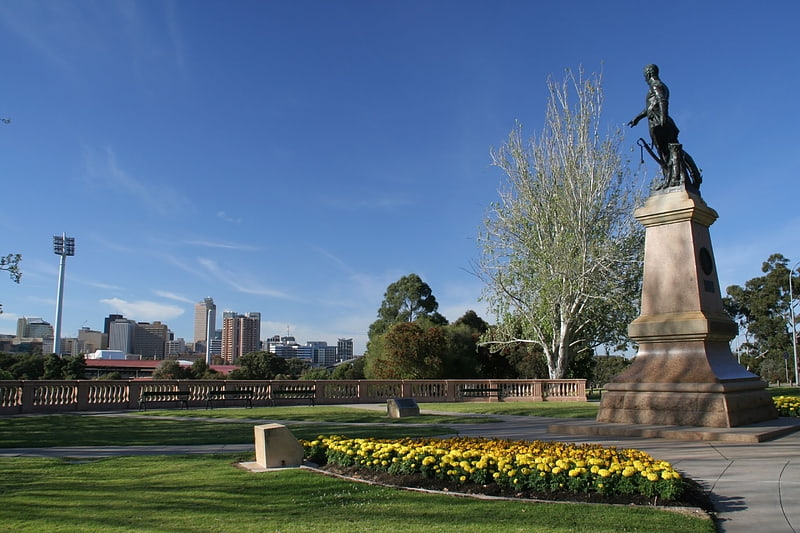
Montefiore Hill is a small hill in North Adelaide, South Australia, which affords a view over the Adelaide city centre.[13]
St Peter's Cathedral
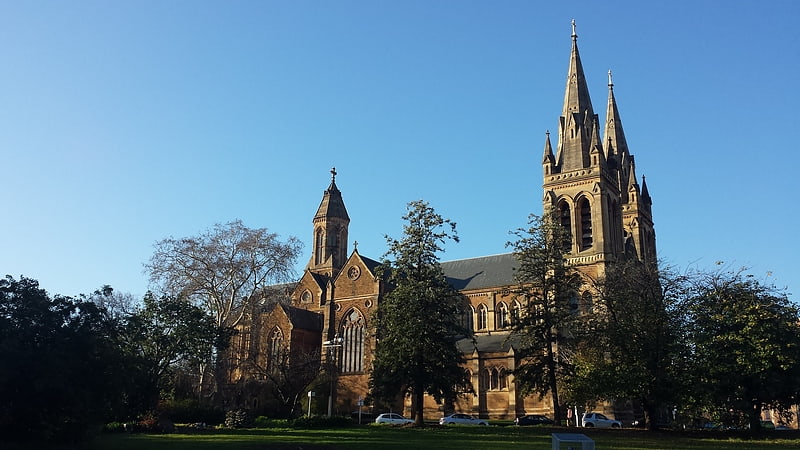
Anglican cathedral consecrated in 1878. St Peter's Cathedral is an Anglican cathedral in the South Australian capital of Adelaide. It is the seat of the Archbishop of Adelaide and Metropolitan of the Province of South Australia. The cathedral, a significant Adelaide landmark, is situated on approximately 1 acre of land at the corner of Pennington Terrace and King William Road in the suburb of North Adelaide.
The south front has similar features to the Cathedral of Notre Dame and the Church of St Jean-Baptiste de Belleville in Paris, including an ornate rose window above the main entrance which depicts stories of South Australia and the Bible.[14]
Address: King William Rd., 5006 North Adelaide
St Francis Xavier's Cathedral
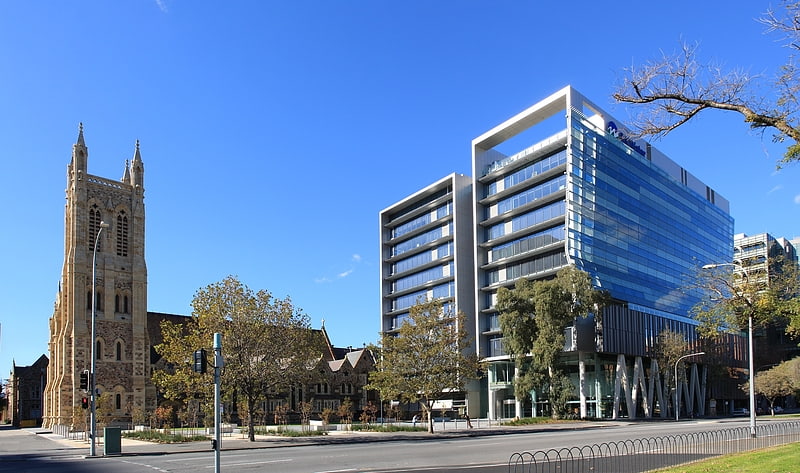
Cathedral in Adelaide city centre, Australia. St Francis Xavier's Cathedral is a Roman Catholic cathedral in Adelaide, South Australia. It is classified as being a Gothic Revival building in the Early English style. The tower stands 36 m high and is 56.5 m lengthwise and 29.5 m horizontally. The foundation stone was laid in 1856 and the building was opened in 1858. The construction of the tower began in 1887. However, it was not completed until 1996.[15]
Address: 39 Wakefield St, 5000 Adelaide (Adelaide)
South African War Memorial
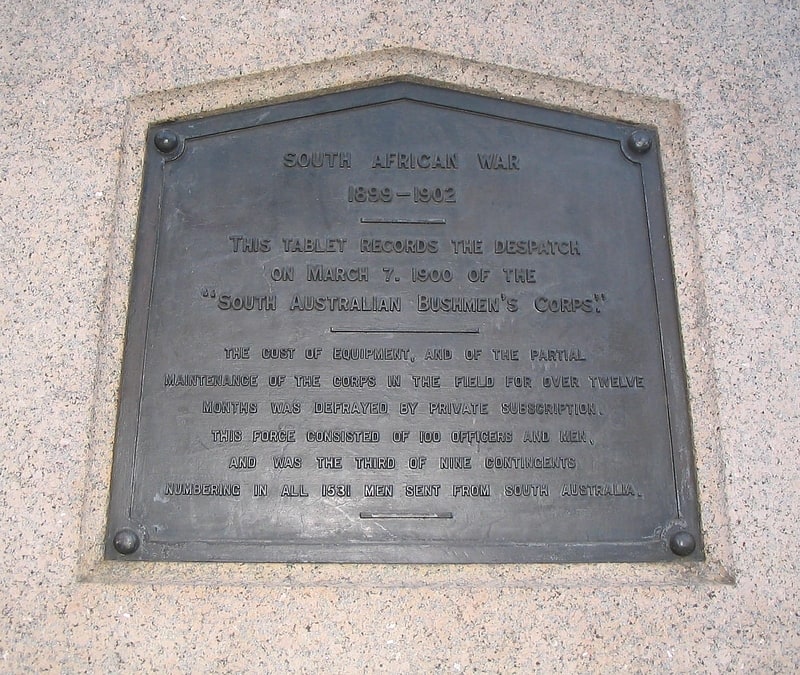
Historical landmark in Adelaide city centre, Australia. The South African War Memorial is an equestrian memorial dedicated to the South Australians who served in the Second Boer War of 11 October 1899 to 31 May 1902. It was the first war in which South Australians fought, and 1531 men were sent in nine contingents, with over 1500 horses to accompany them. Over 59 South Australians died in the war.
The memorial is located in front of the main entrance to Government House, one of the most prominent buildings in Adelaide, on the corner of North Terrace and King William Road. It was constructed with a budget of £2,500 raised through public donations, and was designed by the London-based sculptor Adrian Jones. While the statue itself was not intended to represent any particular soldier, there is evidence suggesting that the head of the rider was based on that of George Henry Goodall.
The statue was unveiled by the Governor of South Australia, George Le Hunte, on 6 June 1904. It has since become one of the focal points for the Anzac day marches, as well as being regarded as one of the most "eye-catching" and significant statues in the city. As such, it was added to the national heritage listing in 1990.[16]
Mount Lofty Fire Tower
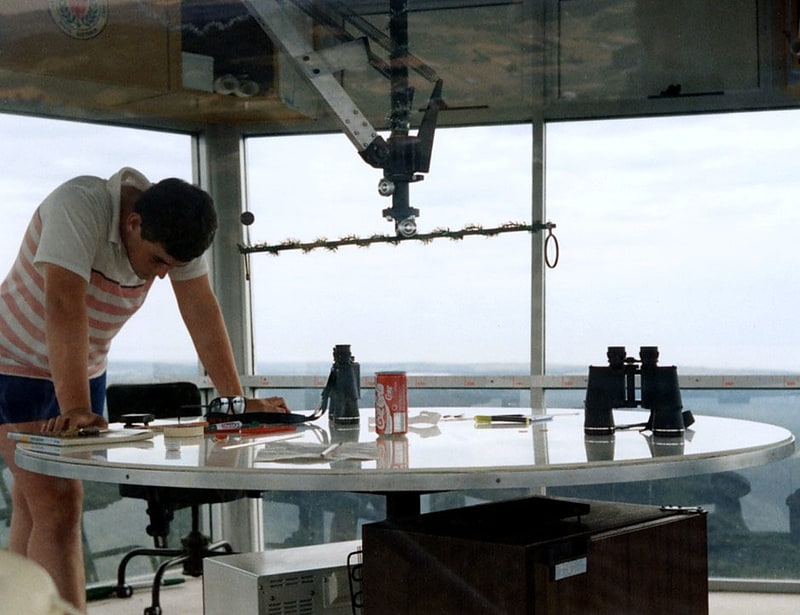
Tower in Cleland, South Australia. The Mount Lofty Fire Tower sits on top of Mount Lofty in the Adelaide Hills just to the east of the city of Adelaide, South Australia. The 34m high tower has a commanding view over a huge area of the rural areas surrounding Adelaide, and on a clear day the view can extend to as far as Kangaroo Island to the southwest, Monarto to the east, the Fleurieu Peninsula to the south, and the grassy plains beyond Two Wells to the north. The tower is used to spot fires in the Adelaide Hills and surrounds on days of very high or extreme fire danger during summer. The spotting crew determine the location of a smoke sighting by taking a bearing and then calculating distance using topographic maps. Details of the sighting are then passed to the 'Adelaide Fire' Communications Centre who despatch the nearest fire brigade.[17]
Address: Mount Lofty Summit Rd, 5152 Crafers
Fort Glanville Conservation Park

State park in Australia. Fort Glanville Conservation Park is a protected area located in the Australian state of South Australia located in Semaphore Park, a seaside suburb of Adelaide consisting of a functional 19th century fort listed on the South Australian Heritage Register and some adjoining land used as a caravan park. The fort was built after more than 40 years of indecision over the defence of South Australia. It was the first colonial fortification in the state and is the best preserved and most functional in Australia. Fort Glanville was designed by Governor Major General Sir William Jervois and Lieutenant Colonel Peter Scratchley, both important figures in early Australian colonial defence. When built it was designed to defend both Semaphore's anchorage and shipping entering the Port River from naval attack.
Construction of the fort began in 1878. It was officially opened in October 1880 and completed by 1882. Due to changes in the Port River and shipping movements, Fort Largs surpassed it for strategic importance by 1890. By the close of the 19th century, the fort was largely unused and had no defence significance. It was briefly used for military purposes during World War I and World War II, though not for its original defensive role. For much of the 20th century the area was put to a variety of uses including accommodation, a caravan park and a boy scout campsite. After coming into state government hands in 1951 it was declared as a conservation park and is now managed by the Department for Environment and Water (DEW); preserving and showcasing its historic value. The fort and surrounds occupy the northern half of the 5-hectare (12-acre) conservation park, the southern half is a caravan park. The fort is a lunette shaped defensible battery that was supported by land forces for self-defence. When constructed it was seen as state of the art, incorporating powerful and modern weapons. Its main armament is two rifled muzzle-loading (RML) 10 inch 20 ton guns backed up by two RML 64 pounder 64 cwt guns, both rare in their particular configuration. The fort retains its original 19th century cannons and three have been restored to working condition.
Fort Glanville Historical Association operates the park under license and conducts open days in the park, recreating the past operation of the fort including military drill and the firing of period weapons. The Association, park service, other volunteers and various grants have all helped ensure the fort is presented in close to original condition. It is the most complete 19th Century fort in Australia, and one of very few in the world that remains in original condition. Connecting the fort to Semaphore jetty is the Semaphore and Fort Glanville Tourist Railway, a 457 mm (18.0 in) gauge passenger steam train operated by volunteers from the National Railway Museum.[18]
Address: 359 Military Road, 5018 Semaphore
Ayers House
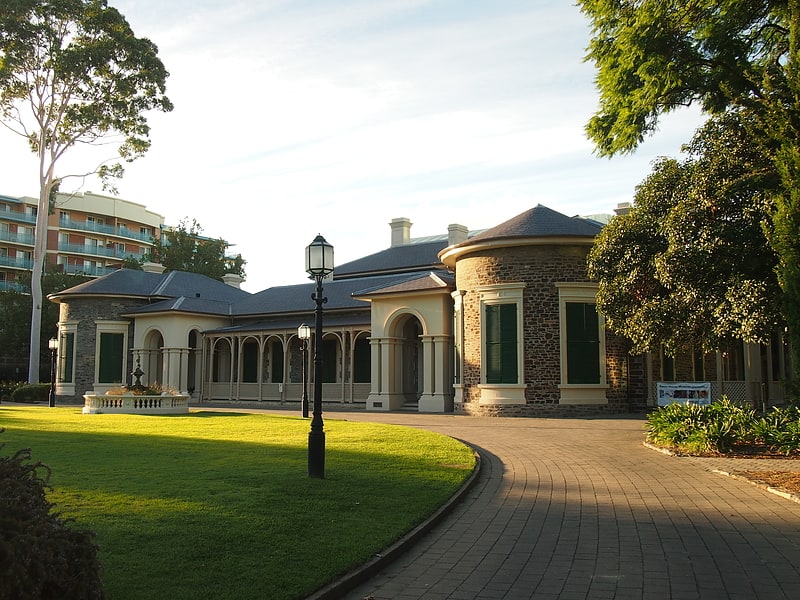
Mansion in Adelaide city centre, Australia. Ayers House is the present-day name for a historic mansion on North Terrace, Adelaide, South Australia. It is named after Sir Henry Ayers, five times Premier of South Australia and wealthy industrialist, who occupied it from 1855 until 1897. It is the only mansion on North Terrace to have survived. The house has been listed on the South Australian Heritage Register since July 1980.[19]
Address: 288 North Terrace, 5000 Adelaide (Adelaide)
National Railway Museum
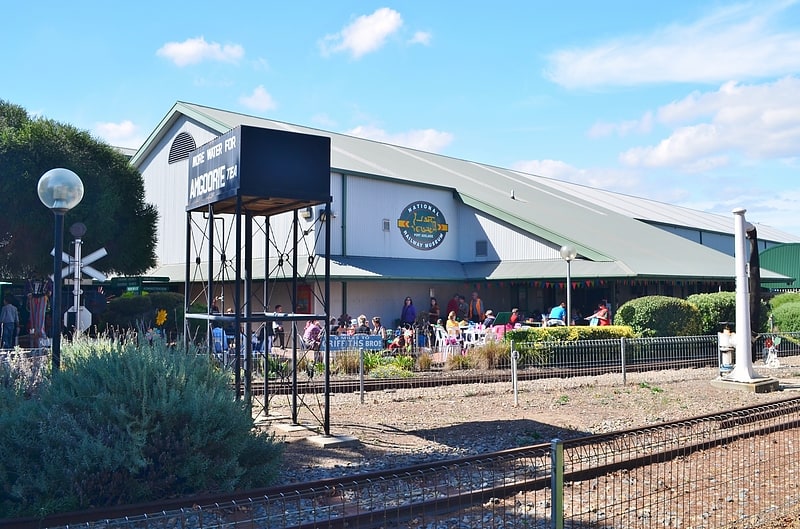
Museum in Australia. Australia's National Railway Museum is the largest railway museum in Australia. More than 100 major exhibits, mainly from the South Australian Railways and Commonwealth Railways and their successor, Australian National, are on display at its 3.5 hectares site in Port Adelaide, South Australia. The museum opened at Lipson Street in 1988 after 18 years at the SAR's former main locomotive depot at Mile End.[20]
Address: 76 Lipson St, 5015 Port Adelaide
Rymill Park

Rymill Park / Murlawirrapurka, and numbered as Park 14, is a recreation park located in the East Park Lands of the South Australian capital of Adelaide. There is an artificial lake with rowboats for hire, a café, children's playground and rose garden, and the Adelaide Bowling Club is on the Dequetteville Terrace side. The Adelaide O-Bahn passes underneath it, to emerge at the western side opposite Grenfell Street.
Before and in the early days of the colonisation of South Australia, the eastern park lands were used as camping grounds for the local Kaurna people and later people from other nearby Aboriginal peoples, such as the Ngarrindjeri.
The park underwent extensive redevelopment, including the construction of the lake, around 1959–1960. It has been used for many cultural and sporting events, in particular Adelaide Fringe, Feast and Festival of Arts events, Carnevale in Adelaide, the Adelaide International Horse Trials. The Fringe venue hub set up on the western side of the park is known as Gluttony.[21]
Address: Bartels Rd, 5000 Adelaide (Adelaide)
South Australian Maritime Museum

Museum in Australia. The South Australian Maritime Museum is a state government museum, part of the History Trust of South Australia. The Museum opened in 1986 in a collection of historic buildings in the heart of Port Adelaide, South Australia's first heritage precinct.[22]
Address: 126 Lipson St, 5015 Port Adelaide
Carrick Hill
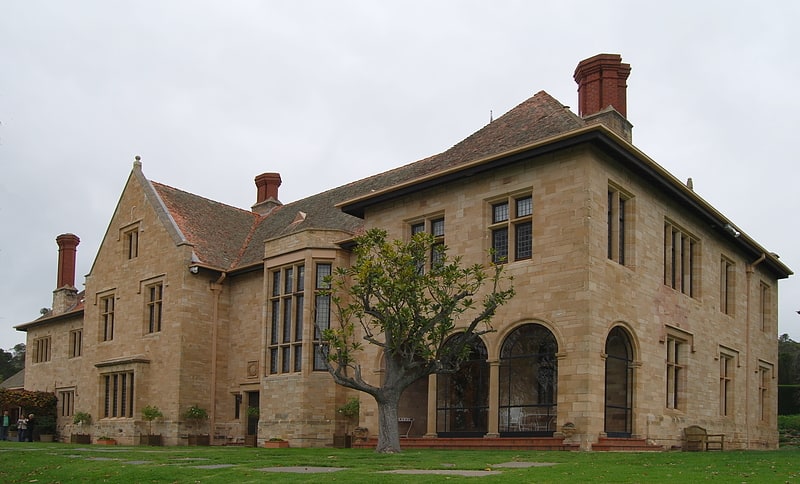
Historical landmark in Australia. Carrick Hill is a publicly accessible historic property at the foot of the Adelaide Hills, in the suburb of Springfield, in South Australia. It was the Adelaide home of Sir Edward "Bill" Hayward and his wife Ursula, and contains a large collection of drawings, sculptures, antiques and paintings. Completed in 1939 and built in the style of an English manor, it is one of the few period homes in Australia to have survived with its grounds undiminished and most of its original contents intact.
After being bequeathed to the state of South Australia upon Sir Edward's death in 1983, since 1985 it has been managed by the board of the Carrick Hill Trust, a statutory corporation which as of 2019 reports to the Department of the Premier and Cabinet.[23]
Address: 46 Carrick Hill Dr, 5062 Springfield
Her Majesty's Theatre
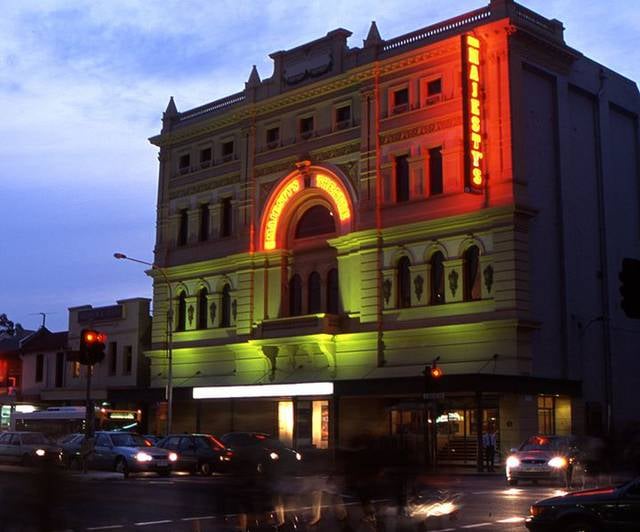
Her Majesty's Theatre is a theatre in Adelaide, South Australia, located on Grote Street, originally built in 1913 as the New Tivoli Theatre. Other names through its history have been the Princess Theatre, the Prince of Wales Theatre, Tivoli Theatre and the Opera Theatre. It re-opened in June 2020 after a major refurbishment.[24]
Address: 58 Grote St, 5000 Adelaide (Adelaide)
Mount Lofty Botanic Garden
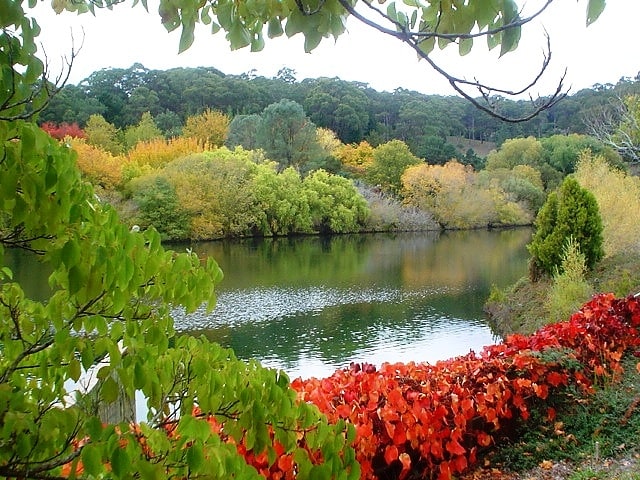
Botanical garden in Crafers, Australia. First opened in 1977, the crescent-shaped Mount Lofty Botanic Garden is situated on 97 hectares on the eastern slopes of Mount Lofty in the Adelaide Hills east of Adelaide in South Australia. The cooler, wetter location suits plants from temperate climates which are difficult to grow on the Adelaide Plains. Amongst the native Australian flora there are tree ferns, as well as exotic cultivated plants from cool climates including Rhododendron and Magnolia and the National Species Rose Collection. The Mount Lofty Botanic Garden, together with the Adelaide and Wittunga Botanic Gardens, is administered by the Botanic Gardens of South Australia, a State Government statutory authority.
In 1980, it was listed on the now-defunct Register of the National Estate.[25]
Address: Lampert Rd, Adelaide
Hazelwood Park
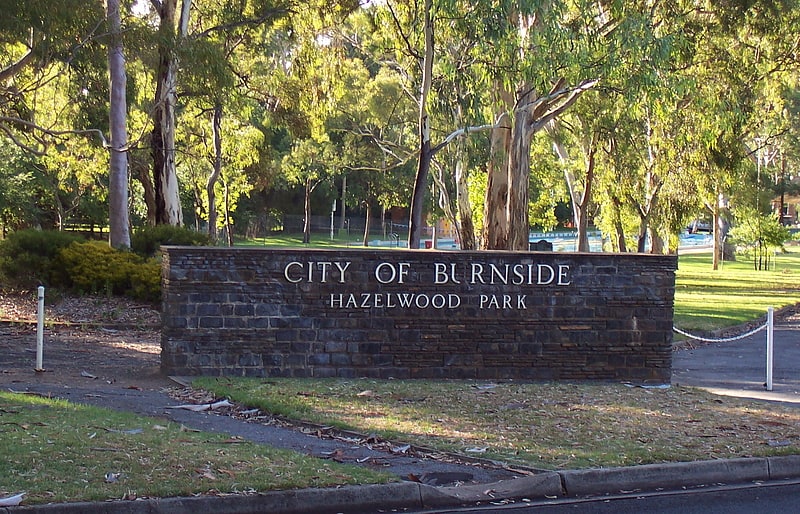
Hazelwood Park is a park in the Australian state of South Australia located in the suburb of Hazelwood Park within the Adelaide Metropolitan Area.
First creek continues its journey from the hills through the park, the water flowing from Waterfall Gully and into Tusmore. The park contains an assortment of play areas, picnic tables and barbecues. It is relatively large by suburban standards, but unusually there are no playing fields. It is strongly characterised by massive old eucalyptus trees that can be seen from blocks away. Although it is well facilitated, it is normally not as popular as the nearby smaller Tusmore Park.
Hazelwood Park was listed on the South Australian Heritage Register on 11 May 1995.[26]
Address: Howard Terrace, 5066 Adelaide
Morialta Conservation Park

Park in Woodforde, South Australia. Morialta Conservation Park, formerly the Morialta Falls Reserve and the Morialta Falls National Pleasure Resort, is a protected area 10 km north-east of Adelaide city centre, in the state of South Australia, Australia. The park is in a rugged bush environment, with a narrow gorge set with three waterfalls, bounded by steep ridges and cliffs. The park caters to many activities, including bushwalking, bird watching and rock climbing.
The name is probably derived from the Kaurna name Marriyarta, meaning "eastern land or country".[27]
Address: Stradbroke Rd, Adelaide
Migration Museum
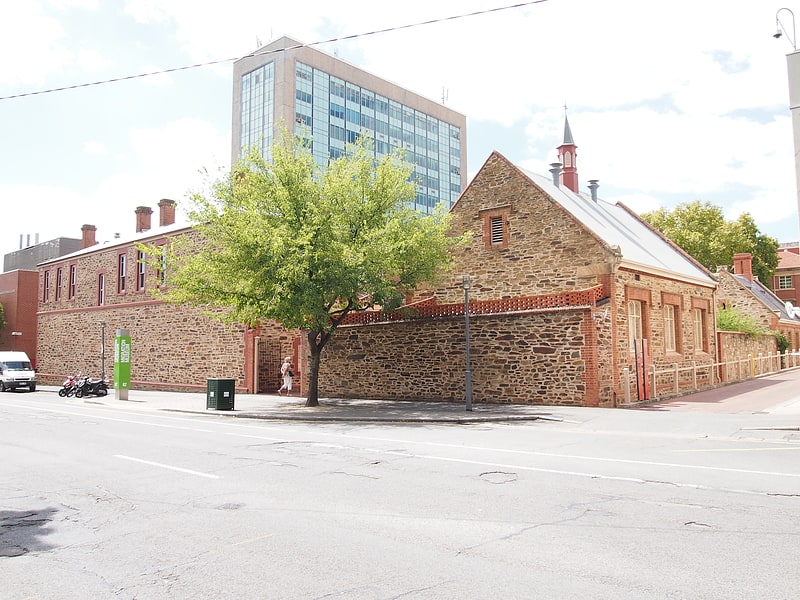
Museum in Adelaide city centre, Australia. The Migration Museum is a social history museum located in Adelaide, South Australia. It is one of the three museums operated by the History Trust of South Australia. It deals with the immigration and settlement history of South Australia, and maintains both a permanent and a rotating collection of works. Founded as an initiative of the State government in 1983, and with the museum opening on 23 November 1986, the Migration Museum in Adelaide is the oldest museum of its kind in Australia. The museum aims to promote cultural diversity and multiculturalism, which they define as including aspects of ethnicity, class, gender, age and region.
The site is located on Kintore Avenue between the State Library of South Australia, the South Australian Museum and the University of Adelaide, in a complex of early colonial bluestone buildings set around a courtyard, including the city's former destitute asylum (from 1850–1918). Before this, the site was the location of the "Native School", which aimed to educate aboriginal children.
The Migration Museum has a full program of activities including education programs for school groups, public events and family friendly fun.[28]
Address: 82 Kintore Ave, 5000 Adelaide (Adelaide)
Adelaide Casino

Casino in Adelaide city centre, Australia. Adelaide Casino, known commercially as SkyCity Adelaide, is a large casino and recreational venue on the north edge of the Adelaide city centre. Located in the heritage-listed Adelaide railway station building on North Terrace, Adelaide, the casino has 90 gaming tables and 950 gaming machines, as well as several bars, function areas and restaurants. Operated as part of the SkyCity Entertainment Group, it is the sole licensed casino in South Australia, regulated by the Independent Gambling Authority and the Liquor and Gambling Commissioner under the Casino Act 1997.
The casino is the 10th largest employer in South Australia, currently employing over 1100 staff members. In 2007 and 2008, Adelaide Casino paid over $41 million in taxes and charges to the state and federal governments.[29]
Address: Adelaide, North Terrace, Adelaide,, South Australia
Elder Park
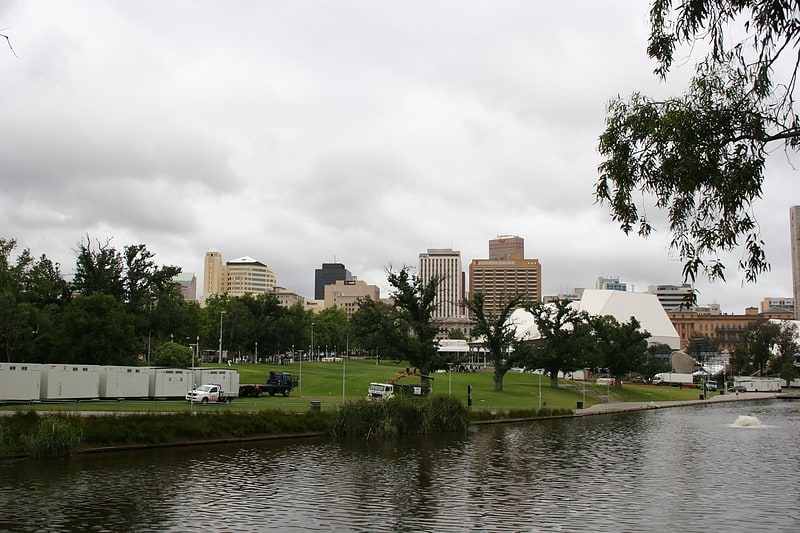
Park in Adelaide city centre, Australia. Elder Park is a public open space in the city of Adelaide, South Australia on the southern bank of the River Torrens and that is bordered by the Adelaide Festival Centre and North Terrace.
The park is named after the Elder family who were early settlers and developed the company Elder Smith (previously known as Goldsbrough Mort).
The Elder Park Rotunda was erected in 1882. The ironwork for the fountain was constructed at the Saracens foundry in Glasgow. The Popeye boat is launched off the banks of the River Torrens, near Elder Park as well as paddleboats. The Torrens Linear Park also passes through Elder Park.
It is the home of the annual Christmas Carols by Candlelight for Adelaide and also hosts Symphony under the Stars and the Adelaide Festival of Arts.
Another Elder Park exists in the Govan area of Glasgow, Scotland; this urban park was gifted to the community by the wealthy philanthropist widow Isabella Elder and named in memory of her late husband John, a successful shipbuilder.[30]
Address: King William Rd, 5000 Adelaide (Adelaide)
Adelaide Himeji Garden

Garden in Adelaide city centre, Australia. Adelaide Himeji Gardens is a traditionally-styled Japanese garden, a gift from Adelaide's sister city, Himeji in 1982. It is located in Park 18, one of the southern parts of the Adelaide Park Lands in Adelaide, South Australia.[31]
Address: 283 South Terrace, 5000 Adelaide (Adelaide)
Torrens Parade Ground
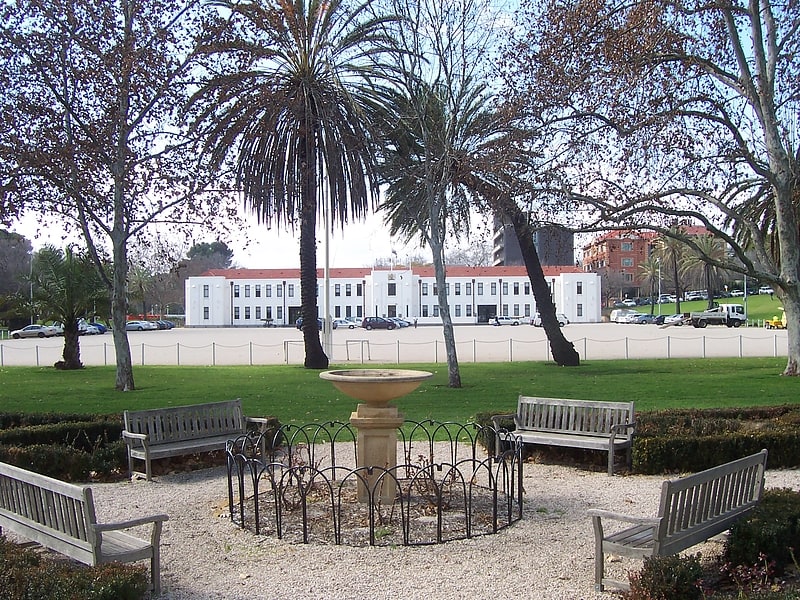
Historical landmark in Adelaide city centre, Australia. Torrens Parade Ground is a former military facility located in Adelaide, South Australia. It is the location of South Australia's Vietnam War Memorial, and the Aboriginal and Torres Strait Islander War Memorial.
The parade ground and drill hall were listed on the South Australian Heritage Register on 11 June 1998. Its significance was reported as follows:
The Torrens Training Depot was built in 1936 and is an excellent example of the Inter-War Stripped Classical style of architecture in Adelaide, particularly as interpreted by architects working for the Commonwealth Government. The strictly symmetrical design of the building and its low scale with simplified classical motifs and Art Deco decorative elements make this one of the most notable buildings in Adelaide of this style to be constructed pre World War Two. The internal arrangement of the building typifies the functional organisation of the Army and its physical requirements. All external detailing which is original to the 1936 building is significant. Internally the open unrestricted form of the drill hall is the most significant aspect. The topography of the Parade Ground indicates the previous use of this area as a quarry for stone and fill for the construction of government buildings, including Government House.
In 1999, it was listed on the now-defunct Register of the National Estate
In 2002 Premier Mike Rann announced and funded a major restoration and upgrade of the Torrens Parade Ground and its heritage listed "Drill Hall and Training Depot" building, to be used as a headquarters for veterans' organisations, and the main office of the History Trust of South Australia.
In 2021, the government announced that there would be a significant development. The grounds would be ripped up and gardens would be put in its place.[32]
Address: Victoria Dr, 5000 Adelaide (Adelaide)
Flinders Street Baptist Church
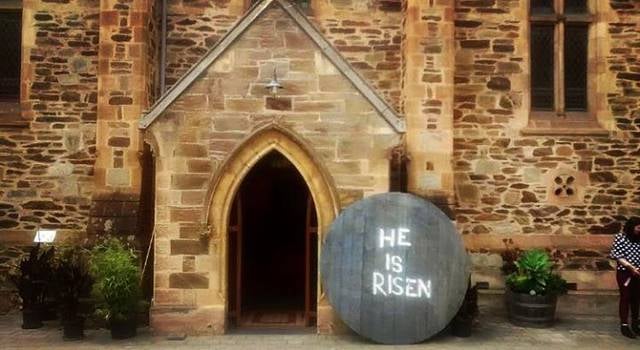
Flinders Street Baptist Church is a church in Adelaide, South Australia.[33]
Address: 65 Flinders St, 5000 Adelaide (Adelaide)
West Terrace Cemetery

Cemetery in Adelaide city centre, Australia. The West Terrace Cemetery is South Australia's oldest cemetery, first appearing on Colonel William Light's 1837 plan of Adelaide. The 27.6 hectares site is located in Park 23 of the Adelaide Park Lands just south-west of the Adelaide city centre, between West Terrace, Anzac Highway, Sir Donald Bradman Drive and the Seaford and Belair railway lines. Originally known as the Adelaide Public Cemetery, it is divided into a number of sections for various communities and faiths, including two Catholic areas, as well as Jewish, Afghan, Islamic and Quaker sections.[34]
Address: 161 West Tce, 5000 Adelaide (Adelaide)
Holy Trinity Church

Evangelical church in Adelaide city centre, Australia. Trinity Church (also known as Holy Trinity Church Adelaide, is an Australian evangelical Anglican church located at 88 North Terrace in the city of Adelaide, South Australia. Trinity Church has five gatherings at the North Terrace location each Sunday, as well as various other meetings throughout the week.[35]
Address: 87 North Terrace, 5000 Adelaide (Adelaide)